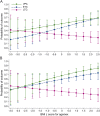Obesity and overweight as CAE comorbidities and differential drug response modifiers
- PMID: 27029636
- PMCID: PMC4844235
- DOI: 10.1212/WNL.0000000000002611
Obesity and overweight as CAE comorbidities and differential drug response modifiers
Abstract
Objective: This study examined whether overweight and obesity are pretreatment comorbidities and predictors of short-term drug response in newly diagnosed untreated childhood absence epilepsy (CAE). We also examined whether dietary intake accounts for observed pretreatment body mass index (BMI) distribution.
Methods: Pretreatment height and weight were available for 445 of 446 participants in the NIH-funded CAE comparative effectiveness trial (NCT00088452). Twenty-four-hour dietary recalls were collected. Calculated BMI and dietary intake were standardized for age, sex, and race/ethnicity and compared to age-matched US population from the National Health and Nutrition Examination Survey (NHANES). Logistic regression models tested BMI as a predictor of treatment response. Pharmacokinetic variables were explored as contributors to differential drug response.
Results: After standardizing for demographic differences, children with CAE were more likely to be overweight (19.3% vs 13.8%; p < 0.001) or obese (14.5% vs 11.5%; p < 0.001) than NHANES controls. The combined prevalence of overweight and obesity was 33.8% in the CAE cohort and 25.3% among controls (p < 0.001). Mean daily energy intake (difference -79.5 kcal/day, p = 0.04) and daily carbohydrate intake (difference -10.7 g/day, p = 0.04) were lower in the CAE group than in NHANES controls. With increasing baseline BMI z score, the efficacy and effectiveness of ethosuximide and valproic acid over lamotrigine became more pronounced, despite no significant differences in drug exposure and trough levels.
Conclusions: Overweight and obesity are more prevalent in children with newly diagnosed CAE than in age-matched peers, despite lower caloric and carbohydrate intake. Baseline BMI may also predict differential drug response, which cannot be attributed to pharmacokinetic differences.
© 2016 American Academy of Neurology.
Figures


References
-
- Available at: http://www.worldobesity.org/aboutobesity/world-map-obesity/?map=children. Accessed May 5, 2014.
-
- Donohoue PA. Obesity. In: Behrman RE, Kliegman RM, Jenson HB, eds. Nelson Textbook of Pediatrics, 17th ed Philadelphia: Saunders; 2004:173–177.
-
- Kramer H, Dugas L, Shoham D. Obesity as an effect modifier of the risk of death in chronic kidney disease. Nephrol Dial Transplant 2013;28(suppl 4):iv65–iv72. - PubMed
-
- Pellock JM. Understanding co-morbidities affecting children with epilepsy. Neurology 2004;62:S17–S23. - PubMed
Publication types
MeSH terms
Substances
Grants and funding
LinkOut - more resources
Full Text Sources
Other Literature Sources
Medical
